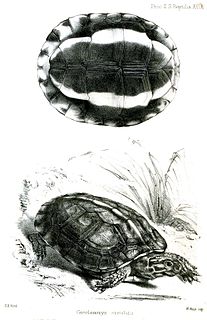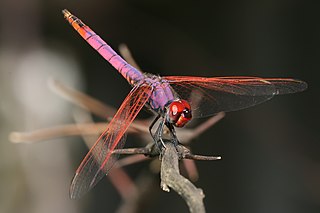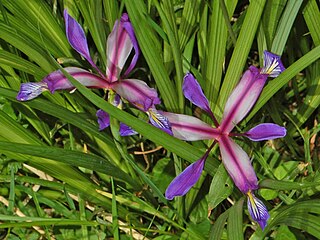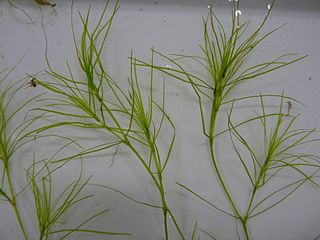
The banded cat-eyed snake is a species of medium-sized, mildly venomous, colubrid snake endemic to the New World.

Theileria is a genus of parasites that belongs to the phylum Apicomplexa, and is closely related to Plasmodium. Two Theileria species, T. annulata and T. parva, are important cattle parasites. T. annulata causes tropical theileriosis and T. parva causes East Coast fever. Theileria species are transmitted by ticks. The genomes of T. orientalis Shintoku, Theileria equi WA, Theileria annulata Ankara and Theileria parva Muguga have been sequenced and published.

Stellaria graminea is a species of flowering plant in the Caryophyllaceae family known by the common names common starwort, grass-leaved stitchwort, lesser stitchwort and grass-like starwort.
Large odorous frog, Odorrana graminea, is a species of frog in the family Ranidae. It is found in southern China (from southern Anhui and northern Zhejiang west to extreme southern Gansu, southeastern Sichuan, and southern Yunnan to the border of Vietnam, Laos and Myanmar, although it has not yet been recorded in the latter two countries. Its type locality is the Wuzhi Mountain in Hainan. Until the revision of "Rana livida" in 2003, this frog was considered a synonym of Odorrana livida. The species occurs near fast-flowing rivers and streams in montane tropical forests.

The brown wood turtle or brown land turtle is a species of turtle in the family Geoemydidae. The species is endemic to Central America and northern South America.

Trithemis annulata, known commonly as the violet dropwing, violet-marked darter, purple-blushed darter or plum-coloured dropwing, is a species of dragonfly in the family Libellulidae. It is found in most of Africa, in the Middle East, in the Arabian Peninsula and southern Europe. These insects are called dropwings because of their habit of immediately lowering their wings after landing on a perch. Males of this species are violet-red with red veins in the wings while females are yellow and brown. Both sexes have red eyes.

Naja annulata, commonly known as the banded water cobra or the ringed water cobra, is a species of water cobra native to western and central Africa. The species is one of the two species of water cobras in the world, the other one being the Congo water cobra.
Melasphaerula is a genus of flowering plants in the family Iridaceae, first described as a genus in 1803. There is only one known species, Melasphaerula graminea, native to Namibia and the Cape Province in South Africa.

The bandy-bandy, also commonly known as the hoop snake, is a species of venomous snake in the family Elapidae. The species is endemic to Australia. It is considered weakly venomous.

Nyctemera annulata, commonly known as the magpie moth, is a moth of the family Erebidae. It is endemic to New Zealand and found in all parts of the country.

Iris graminea, is a species in the genus Iris belonging to the subgenus Limniris, in particular the series Spuriae. It is a rhizomatous perennial, with purple or violet blue flowers almost hidden by narrow, grass-like leaves, and a plum scented fragrance. It is cultivated as an ornamental plant in temperate regions. It has several common names, including grass-leaved flag, grass leaved iris, plum iris and plum tart iris. This species naturally occurs in the southern half of Europe, from Spain and France in the West to Russia and the Caucasus in the East.

Actinia is a genus of sea anemones in the family Actiniidae.

Najas graminea, also known as ricefield water-nymph is a species of aquatic plant found in freshwater habitats, especially still or slow-moving waters, like ponds and rice fields. It grows to a maximum length of 30 cm. The flowers are monoecious. The flowering season is from July to September.

Naja christyi, commonly known as the Congo water cobra or Christy's water cobra, is a species of venomous snakes belonging to the family Elapidae. The species is native to Sub-Saharan Africa. This species was formerly in the genus Boulengerina, but more recent research by Wallach et al. has shown that Boulengerina is actually a subgenus and Boulengerina christyi is a synonym of Naja christyi. This species has no known subspecies.
This article lists the various snakes of Australia which live in a wide variety of habitats around the continent. The amethystine python or scrub python is considered Australia's largest native snake.

Gilliesia is a genus in the family Amaryllidaceae. The entire genus is native to Chile and Argentina.

Sagittaria graminea, the grassy arrowhead or grass-leaved arrowhead, is an aquatic plant species native to eastern North America. It is known from every Canadian province from Ontario to Newfoundland, and every US state from the Great Plains to the Atlantic, plus Colorado, New Mexico and Cuba. It is considered naturalized in Washington State and in Vietnam.
Calliini is a tribe of longhorn beetles of the Lamiinae subfamily.
Graminea is a genus of longhorn beetles of the subfamily Lamiinae.

Persoonia graminea is a shrub native to the south-west of Western Australia, where it is found on poorly-drained or loamy soils.
















